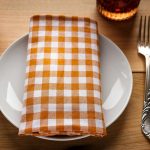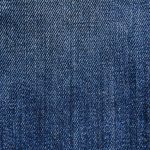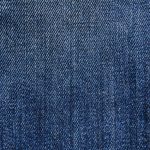You’ll find that gingham fabric originated in the 17th century, woven initially in Southeast Asia, especially India and Indonesia. Its simple checked pattern made from cotton or silk caught European traders’ attention, spreading through expanding trade routes. The name “gingham” likely comes from the Malay word for striped, “genggang.” Gingham caught on quickly in Europe and remains popular today. If you keep exploring, you’ll discover how it became a fashion and cultural staple worldwide.
Table of Contents
Key Takeaways
- Gingham fabric originated in the 17th century, first woven in India and Indonesia with simple checked patterns.
- The term “gingham” derives from the Malay word “genggang,” meaning striped, entering Europe via Dutch and English traders.
- Gingham was introduced to European markets in the 1600s through expanding trade routes with Southeast Asia.
- It gained popularity in Europe during the 18th and 19th centuries for clothing and household textiles.
- The fabric’s design evolved from striped to the iconic checked pattern recognized today.
Origins of Gingham Fabric
Although many people associate gingham fabric with classic American fashion, its origins actually trace back to Southeast Asia and Europe centuries ago.
Gingham fabric, often linked to American style, actually began centuries ago in Southeast Asia and Europe.
You’ll find that early versions appeared in the 17th century, initially woven in places like India and Indonesia. These fabrics featured simple checked patterns, crafted from cotton or silk.
When European traders arrived, they adopted and adapted the design, spreading it through countries like England and the Netherlands.
You might be surprised to learn that the fabric was initially prized for its durability and affordability, making it popular for everyday clothing and household items.
As you explore gingham’s history, you’ll see how this humble cloth evolved from practical roots into a timeless pattern recognized worldwide.
The Etymology of the Word “Gingham”
Understanding the origins of gingham fabric leads naturally to the story behind its name.
When you explore the etymology of “gingham,” you’ll uncover a fascinating linguistic journey. Here’s what you need to know:
- The word “gingham” likely comes from the Malay word “genggang,” meaning striped, reflecting the fabric’s early striped patterns.
- It entered European languages in the 17th century as Dutch and English traders encountered the fabric in Southeast Asia.
- Over time, “gingham” evolved to describe the checked pattern we recognize today, not just stripes.
Gingham in Southeast Asia
You’ll find that gingham arrived in Southeast Asia through trade and colonial influence, quickly becoming part of local textiles.
People adapted the fabric for traditional clothing and everyday wear, blending it with their own styles.
Today, gingham still shapes contemporary fashion trends across the region, showing its lasting impact.
Historical Arrival in Region
When European traders and colonizers reached Southeast Asia in the 17th century, they introduced gingham fabric to the region.
You’d find that gingham quickly became part of trade goods due to its durability and appealing patterns.
If you look closer, you’ll notice three key factors in its arrival:
- Trade Routes: Gingham arrived via established maritime routes connecting Europe, India, and Southeast Asia.
- Market Demand: Local merchants and consumers appreciated gingham for its affordability and style.
- Colonial Influence: European powers promoted fabric imports to support their economic interests.
Cultural Adaptations and Uses
Once gingham found its way into Southeast Asia, local communities began adapting the fabric to fit their customs and lifestyles. You’ll see gingham used in traditional attire, home décor, and everyday wear, blending both practicality and cultural expression. Its lightweight and breathable nature makes it perfect for the tropical climate. As you explore, notice how patterns and colors have evolved to reflect local tastes and symbolism.
| Country | Common Use | Cultural Significance |
|---|---|---|
| Indonesia | Sarongs, shirts | Symbolizes simplicity and work |
| Thailand | Market bags, scarves | Used in everyday market life |
| Philippines | Barong fabric lining | Blends colonial and native styles |
| Vietnam | Headscarves | Represents rural identity |
| Malaysia | Tablecloths | Used in festive gatherings |
Contemporary Fashion Influence
Gingham’s timeless charm has found new life in Southeast Asia’s contemporary fashion scene. You’ll notice designers blending traditional gingham with modern styles, creating fresh looks that honor heritage while appealing to today’s trends.
If you want to embrace gingham’s versatility in Southeast Asia, consider these key influences:
- Streetwear Fusion – Gingham patterns appear on oversized shirts and accessories, mixing casual and chic effortlessly.
- Sustainable Fashion – Local brands use gingham fabric from eco-friendly sources, promoting conscious consumerism.
- Cultural Revivals – Designers incorporate gingham into traditional garments, like sarongs and kebayas, updating them for modern wear.
When you wear gingham in Southeast Asia, you join a movement that values history, sustainability, and style, making a bold yet meaningful fashion statement.
Introduction of Gingham to Europe
You’ll see how gingham first arrived in European markets, quickly catching the eye of local weavers who began producing their own versions.
You’ll also learn why this fabric became a favorite among the nobility, shaping fashion trends across the continent.
Let’s explore how gingham’s European journey unfolded.
Arrival in European Markets
Several factors helped gingham fabric find its way into European markets during the 17th century. You’d be surprised how quickly this striped and checked cotton gained popularity.
First, expanding trade routes connected Europe with Southeast Asia, where gingham originally came from.
Second, European merchants recognized its durability and affordable production costs, making it a practical choice for everyday wear.
Third, the fabric’s simple yet attractive patterns appealed to a wide range of consumers, from peasants to the emerging middle class.
These reasons combined to boost gingham’s demand across various European countries.
As you explore the fabric’s journey, you’ll see how these elements laid the groundwork for gingham’s widespread use before local production even began.
Understanding this stage is key to appreciating its historical significance.
Early European Production
By the mid-17th century, European weavers had started producing gingham locally, adapting techniques to recreate its distinctive checked patterns.
You’d find these fabrics initially in textile hubs like England, the Netherlands, and France, where skilled artisans experimented with yarn-dyeing and weaving methods to match the vibrant, durable cotton from Asia.
As a weaver or merchant, you’d notice how gingham’s simple yet striking design made it easier to produce compared to intricate brocades or tapestries.
This local production reduced reliance on imports and allowed quicker response to market demands.
When you buy gingham fabric during this period, you’re getting a product that reflects both foreign inspiration and European craftsmanship, marking the beginning of gingham’s integration into Western textile traditions.
Popularity Among Nobility
Gingham’s bold checks quickly caught the eye of European nobility as the fabric made its way from Asia. You’d find it becoming a symbol of elegance and refinement in royal courts.
Its unique pattern and lightweight nature made it ideal for various garments worn by the elite. Here’s why it gained such popularity among nobility:
- Distinctive Appearance – The crisp, contrasting checks stood out in elaborate wardrobes, signaling sophistication.
- Versatility – Nobles used gingham for dresses, shirts, and even home decor, showcasing its multifunctional appeal.
- Status Symbol – Wearing gingham became a mark of wealth and worldly taste, as it was initially imported and rare.
You’ll see that gingham wasn’t just fabric; it was a fashion statement among the privileged.
Gingham’s Popularity in the 18th and 19th Centuries
Although it originated centuries earlier, gingham really caught on during the 18th and 19th centuries, becoming a favorite for everyday clothing and household items. You’d find its simple checkered pattern on dresses, shirts, aprons, and even curtains.
Because gingham was affordable and durable, it suited the growing middle class perfectly. As textile production improved, gingham became widely available, making it easier for you to wear stylish yet practical fabrics. Its crisp, clean look appealed to many, symbolizing neatness and modesty.
Whether you lived in the city or countryside, gingham was everywhere. You could spot it at markets, farms, and homes alike. This period helped cement gingham’s place as a staple fabric in everyday life, bridging function with a touch of charm.
Modern Uses and Cultural Significance of Gingham
While gingham once symbolized modesty and practicality, today you’ll find it embraced in fashion and design for its timeless charm and versatility.
You can spot gingham patterns in various modern contexts, proving its enduring appeal. Here are three key ways gingham remains relevant:
- Fashion staple: Designers use gingham in everything from casual shirts to elegant dresses, making it a go-to pattern for all seasons.
- Home decor: You’ll see gingham in curtains, tablecloths, and cushions, adding a cozy, vintage touch to interiors.
- Cultural icon: Gingham often represents nostalgia and simplicity, frequently appearing in films and celebrations to evoke warmth and tradition.
Frequently Asked Questions
How Is Gingham Fabric Typically Made?
You weave cotton threads, you dye them in stripes, and you interlace them in a checkered pattern. You keep the weave balanced, creating gingham’s signature look that’s simple, neat, and perfectly classic for your projects.
What Colors Are Most Common in Gingham Patterns?
You’ll most often see gingham patterns in classic colors like red, blue, black, and green paired with white. These combinations give it that timeless, fresh look you probably recognize from shirts and tablecloths.
Is Gingham Fabric Durable and Easy to Care For?
You’ll find gingham fabric quite durable and easy to care for. It’s usually cotton or a cotton blend, so you can machine wash and iron it without hassle, making it perfect for everyday wear and home decor.
Can Gingham Fabric Be Used for Upholstery?
You can use gingham fabric for upholstery, but keep in mind it’s typically lightweight and may not hold up well under heavy use. For durability, consider a heavier blend or treat it with a protective finish first.
How Does Gingham Differ From Plaid and Tartan?
You’ll notice gingham has simple, evenly spaced checks with two colors, while plaid and tartan feature more complex, overlapping stripes in multiple colors. Gingham’s pattern is cleaner and less intricate than tartan’s traditional design.
- A Deep Dive Into 100% Aramid Fabric - June 22, 2025
- The Aramid Non-Crimp Fabric Market: Trends & Forecast - June 22, 2025
- Aramid Knitted Fabric: Flexibility Meets Extreme Strength - June 22, 2025







